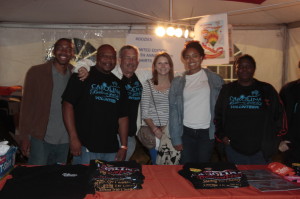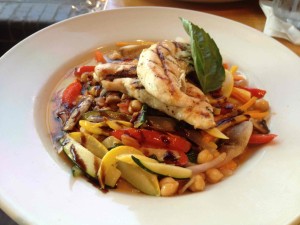By Jeffrey Flitter and Immanuel Bryant, 2013
The Statesville Balloon Festival is an event held every year in Statesville, NC that brings together more than 30 hot air balloons for a competition. Our group of four – Immanuel Bryant, Anna Mokas, Taylor Hill, and Jeffrey Flitter – followed a massive line of cars through the back roads of Statesville to find the festival on a local airport’s property. We arrived to a massive open field filled with spectators, balloons preparing to take off, food booths, artists booths, and a concert stage. The hill was filled with lots of people watching the balloons set up and prepare for the event. We began by standing at the top of the hill and waiting for the balloons to take off.
 We didn’t have to wait long before the first balloon hit the air. We cut it close, but thankfully made it just in time for the balloon race to begin. As we watched the balloons begin to take off, we, along with everyone else at the festival, grabbed our cameras and started to snap tons of pictures. Everyone at the festival enjoyed watching the balloons and took up the challenge of skirting around children, families, and photographers to get pictures of the balloons, their children, and others. The ascension of the balloons took about thirty minutes in total, but it felt like the blink of an eye before they were all in the air. We felt there had to be more to this than simply balloons rising into the air; otherwise, what was the point.
We didn’t have to wait long before the first balloon hit the air. We cut it close, but thankfully made it just in time for the balloon race to begin. As we watched the balloons begin to take off, we, along with everyone else at the festival, grabbed our cameras and started to snap tons of pictures. Everyone at the festival enjoyed watching the balloons and took up the challenge of skirting around children, families, and photographers to get pictures of the balloons, their children, and others. The ascension of the balloons took about thirty minutes in total, but it felt like the blink of an eye before they were all in the air. We felt there had to be more to this than simply balloons rising into the air; otherwise, what was the point.
A volunteer working the festival’s ticket exchange explained to us what was actually happening during the festival: a hot-air balloon competition. He described the different types of competitions that could take place to us. He said that day’s competition involved the first balloon taking off while all the other balloons chased after it. The first balloon would sometimes leave a trail of items in trees that the other balloons would have to retrieve. Sometimes it is an old fashioned race where the only goal was to reach the place where the first balloon lands before all the other balloons.
 After the balloons were in the air and the competition had been explained to us, we began to look around the rest of the festival. We noticed many tents set up featuring local artisans displaying their crafts, local vendors with fudge and alcohol, a music stage, and the large food tents with the boards that anyone who has ever attended a festival in the south would recognize. We all decided to get different foods from the tent so that we had a variety of opinions. Jeff was adamant that the food was good but that it was the same food you would find at any festival or fair. Having some extra tickets, Jeff went to buy a beer. He was disappointed when the local brews were not part of the ticket system, but he bought a local brew anyway and thoroughly enjoyed it. While eating, we sat down and watched the musical performance.
After the balloons were in the air and the competition had been explained to us, we began to look around the rest of the festival. We noticed many tents set up featuring local artisans displaying their crafts, local vendors with fudge and alcohol, a music stage, and the large food tents with the boards that anyone who has ever attended a festival in the south would recognize. We all decided to get different foods from the tent so that we had a variety of opinions. Jeff was adamant that the food was good but that it was the same food you would find at any festival or fair. Having some extra tickets, Jeff went to buy a beer. He was disappointed when the local brews were not part of the ticket system, but he bought a local brew anyway and thoroughly enjoyed it. While eating, we sat down and watched the musical performance.
The performance featured a small band, but it was more than enough for the audience. People were dancing in front of the stage, children were running around, and many people sat and simply enjoyed the music. One number brought children and adults on stage to do a “chicken dance” to the amusement of everyone in the audience. Seeing a wide range of people from an elderly woman to young toddlers shaking their “tail feathers” was an amusing site for sure.
Having extra tickets from the dinner, especially since Jeff could not use them for his beer, we collectively purchased a funnel cake. Eating the funnel cake as the sun faded from view and was replaced with a darkening sky was a perfect setting to end the day on. We finished our funnel cake, finished taking some notes in our travel journals, and headed for the exit.
Of course exiting an event like this is never as easy or quick as one expects. On the way out, we thought it would be a wise idea to stop at the information tent and get some information and make sure we had our facts straight. We instead had a discussion with the workers about what brought them to the fair and why they did it. One woman described how she had been on the committee for the festival for many years and loved it. She also explained to us that the festival supports a non-profit or social cause every year. This year the event was supporting Relay For Life of Statesville & local charities, but the discussion to change it came up every few years and they would vote to keep it the same or change it. Having all the information we needed, we began to leave. We paused as we came up with an idea and decided to turn around and make our way back to the tent. We arrived back and promptly asked to take a group photo with the information tent workers, to which they happily agreed.
Having our pictures, information, and experiences compiled within our minds and journals, we piled into the car and made our way to the hotel for the night.





